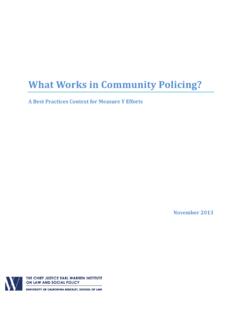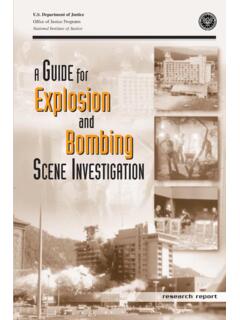Transcription of Mapping Crime: Principle and Practice - Office of Justice ...
1 DEPARTMENTOFJUSTICE Department of JusticeOffice of Justice ProgramsNational Institute of JusticeMAPPING CRIMEMAPPING CRIMEPRINCIPLE AND Department of JusticeOffice of Justice Programs810 Seventh Street , DC 20531 Janet RenoAttorney GeneralDaniel MarcusActing Associate Attorney GeneralLaurie RobinsonAssistant Attorney GeneralNo l BrennanDeputy Assistant Attorney GeneralJeremy TravisDirector, National Institute of JusticeOffice of Justice ProgramsNational Institute of JusticeWorld Wide Web SiteWorld Wide Web Site the National Institute of JusticeThe National Institute of Justice (NIJ), a component of the Office of Justice Programs, is the research agency of the Department of Justice .
2 Created by the Omnibus Crime Control and Safe Streets Act of 1968, as amended,NIJ is authorized to support research, evaluation, and demonstration programs, development of technology, and both national and international information dissemination. Specific mandates of the Act direct NIJ to:lSponsor special projects, and research and development programs, that will improve and strengthen the criminal Justice system and reduce or prevent crime. lConduct national demonstration projects that employ innovative or promising approaches for improving criminal Justice . lDevelop new technologies to fight crime and improve criminal Justice . lEvaluate the effectiveness of criminal Justice programs and identify programs that promise to be successful if continued or repeated.
3 LRecommend actions that can be taken by Federal, State, and local governments as well as by private organizationsto improve criminal Justice . lCarry out research on criminal behavior. lDevelop new methods of crime prevention and reduction of crime and delinquency. In recent years, NIJ has greatly expanded its initiatives, the result of the Violent Crime Control and Law EnforcementAct of 1994 (the Crime Act), partnerships with other Federal agencies and private foundations, advances in technology, and a new international focus. Some examples of these new initiatives:lNew research and evaluation are exploring key issues in community policing , violence against women, sentencingreforms, and specialized courts such as drug courts.
4 LDual-use technologies are being developed to support national defense and local law enforcement needs. lThe causes, treatment, and prevention of violence against women and violence within the family are being investigated in cooperation with several agencies of the Department of Health and Human Services. lNIJ s links with the international community are being strengthened through membership in the United Nations network of criminological institutes; participation in developing the Criminal Justice Information Network;initiation of UNOJUST ( Online Justice Clearinghouse), which electronically links the institutes to the network; and establishment of an NIJ International Center.
5 LThe NIJ-administered criminal Justice information clearinghouse, the world s largest, has improved its online capability. lThe Institute s Drug Use Forecasting (DUF) program has been expanded and enhanced. Renamed ADAM (Arrestee Drug Abuse Monitoring), the program will increase the number of drug-testing sites, and its role as a platform for studying drug-related crime will grow. lNIJ s new Crime Mapping Research Center will provide training in computer Mapping technology, collect andarchive geocoded crime data, and develop analytic software. lThe Institute s program of intramural research has been expanded and enhanced. The Institute Director, who is appointed by the President and confirmed by the Senate, establishes the Institute s objectives, guided by the priorities of the Office of Justice Programs, the Department of Justice , and the needs of the criminal Justice field.
6 The Institute actively solicits the views of criminal Justice professionals and researchers in the continuing search for answers that inform public policymaking in crime and Department of JusticeOffice of Justice ProgramsNational Institute of JusticeWashington, DC 20531 Official BusinessPenalty for Private Use $300 SPECIAL STANDARD MAILPOSTAGE & FEES PAIDDOJ/NIJPERMIT NO. G 91 Mapping Crime: Principle and PracticeResearch Department of JusticeOffice of Justice Programs810 Seventh Street , DC 20531 Janet RenoAttorney GeneralDaniel MarcusActing Associate Attorney GeneralLaurie RobinsonAssistant Attorney GeneralNo l BrennanDeputy Assistant Attorney GeneralJeremy TravisDirector, National Institute of JusticeOffice of Justice ProgramsNational Institute of JusticeWorld Wide Web SiteWorld Wide Web Site Crime: Principle and PracticeKeith Harries, 1999 NCJ 178919 Jeremy TravisDirectorNancy La VigneProgram MonitorThis project was supported by Grant No.
7 98 LB VX 0009 awarded by the National Institute ofJustice, Office of Justice Programs, Department of Justice . Points of view in this documentare those of the author and do not necessarily represent the official position or policies of the of National Institute of Justice is a component of the Office of Justice Programs, which also includes theBureau of Justice Assistance, the Bureau of Justice Statistics, the Office of Juvenile Justice and DelinquencyPrevention, and the Office for Victims of CreditsClockwise, starting with upper left corner:Map by Lodha and Verma, 1999 Map by Jeff Stith and the Wilson, North Carolina, Police DepartmentMap by Wilpen Gorr, Heinz School of Public Policy andManagement, Carnegie Mellon University, Pittsburgh, PennsylvaniaMap by Susan Wernicke, Overland Park, Kansas, Police DepartmentMap by ASDI Technologies, Colorado Springs, ColoradoMap by Jeff Stith and the Wilson, North Carolina, Police DepartmentiiiMapping Crime.
8 Principle and PracticeAcknowledgmentsWithout the generous cooperation ofmany people in various settings, includingpolice departments and universities, thevariety of examples and particularly illus-trations presented in this guide would nothave been possible. Some individuals whoshould have been acknowledged belowmay have been inadvertently omitted, andI apologize if that is the case. Amongthose who must be singled out for specialrecognition are the following (in alphabet-ical order):Al Ball, Office of Community OrientedPolicing Services (COPS) RegionalInstitute, Cincinnati, Ohio; Rachel Boba,Tempe Police Department, Tempe,Arizona; Chris Bruce, Cambridge PoliceDepartment, Cambridge, Massachusetts;Jim Bueermann, Redlands PoliceDepartment, Redlands, California; Philip Canter, Baltimore County PoliceDepartment, Towson, Maryland; PeterDana, University of Texas, Austin, Texas;Wilpen Gorr, Heinz School, CarnegieMellon University, Pittsburgh,Pennsylvania.
9 Elizabeth Groff, CrimeMapping Research Center, NationalInstitute of Justice , Washington, ; HalHoltzman, Department of Housingand Urban Development, Washington, ; James LeBeau, Southern IllinoisUniversity, Carbondale, Illinois; Suresh , University of California, SantaCruz, California; Mark Mattson, TempleUniversity, Philadelphia, Pennsylvania;Tom McEwen, Institute for Law andJustice, Alexandria, Virginia; Phillip , New York City PoliceDepartment, New York, New York; SaraMcLafferty, Hunter College, New York,New York; Robert Moland, St. PetersburgPolice Department, St. Petersburg, Florida;Tracy Molfino, Salinas Police Department,Salinas, California; Lew Nelson,Environmental Systems ResearchInstitute, Inc.
10 , Redlands, California; MikeNeumann, Cincinnati Police Department,Cincinnati, Ohio; Andreas Olligschlaeger,Carnegie Mellon University, Pittsburgh,Pennsylvania; George Rengert, TempleUniversity, Philadelphia, Pennsylvania; D. Kim Rossmo, Vancouver PoliceDepartment, Vancouver, British Columbia,Canada; Mark Stallo, Dallas PoliceDepartment, Dallas, Texas; Gerry Tallman,Overland Park Police Department,Overland Park, Kansas; Deb Thomas,University of South Carolina, Columbia,South Carolina; Arvind Verma, IndianaUniversity, Bloomington, Indiana; JulieWartell, Institute for Law and Justice ,Alexandria, Virginia; John Werner, MesaPolice Department, Mesa, Arizona; Susan Wernicke, Overland Park PoliceDepartment, Overland Park, Kansas; DougWilliamson, Center for Applied Studies ofthe Environment (CAPSE), City Universityof New York, New York, New York.












